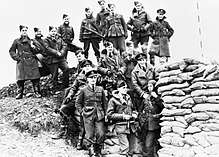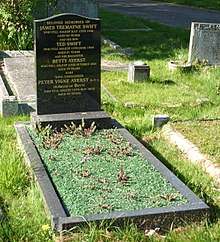Peter Ayerst
Peter Vigne Ayerst, DFC (4 November 1920 – 15 May 2014)[1] was a Royal Air force officer and flying ace of the Second World War.[2] He was the last surviving No. 73 Squadron pilot and test pilot from Castle Bromwich Aerodrome.[1]
Peter Vigne Ayerst | |
|---|---|
 Ayerst (bottom left) in France | |
| Born | 4 November 1920 Westcliff-on-Sea, Essex |
| Died | 15 May 2014 (aged 93) |
| Buried | Canterbury, Kent |
| Allegiance | United Kingdom |
| Service/ | Royal Air Force |
| Rank | Wing Commander |
| Unit | No. 73 Squadron RAF |
| Battles/wars | Second World War |
| Awards | Distinguished Flying Cross |
Early life
Ayerst was born on 4 November 1920 in Westcliff-on-Sea, Essex, England. He was educated at Westcliff High School for Boys, a state grammar school in his home town.[3]
Military career
Ayerst was commissioned into the Royal Air Force on 14 December 1938 as an acting pilot officer on probation.[4] In August 1939, he was posted to No. 73 Squadron RAF to fly Hurricanes.[5] He was regraded to pilot officer on probation on 3 September 1939 and his commission was confirmed on 6 October 1939.[6]
He was sent to France with the squadron and scored his first victory in April 1940. After a spell instructing, when he shared in the destruction of a He 111 with two other instructors, he had postings with both 145 and 243 Squadrons.
In July 1942 he went to North Africa with 33 Squadron,[5][7] before being promoted to flight commander with 238 Squadron, both postings with further combat success. After a period in South Africa, he returned to the UK, joining 124 Squadron flying Spitfire MkVIIs in defence of the invasion ports, where he scored his final victory; then flew Spitfire MkIXs on bomber escorts to Germany. He later became a Spitfire test pilot at Castle Bromwich with the instruction of Alex Henshaw.[1] After the war, he became one of the most highly regarded wartime instructors in the RAF.[8] His final victory tally stood at 5 destroyed, 1 probable, 3 damaged and 2 further destroyed on the ground. In September 1944, he was awarded the Distinguished Flying Cross.[5]
Later life

Ayerst was involved in a biography about his military experience tilted Spirit of the Blue: A Fighter Pilot's Story. It was published 2004.[7] He died on 15 May 2014 at the age of 93, and is buried in Canterbury, Kent.[9]
References
- "UK Commemorates Battle of Britain Commander". sys-con.com. 4 November 2009. Retrieved 8 September 2012.
- "Pilot is reunited with his WWII Spitfire in London". news.bbc.co.uk. 30 April 2010. Retrieved 8 September 2012.
- "Wing Commander Peter Ayerst". The Times. 30 June 2014. Retrieved 30 June 2014.
- "No. 34583". The London Gazette. 27 December 1938. p. 8249.
- "Two generations join in the air". Evening Standard. 16 May 2008. Retrieved 8 September 2012.
- "No. 34705". The London Gazette. 10 October 1939. p. 6796.
- Spirit of the Blue: Peter Ayerst: A Fighter Pilot's Story. books.google.com. 1 October 2005. Retrieved 8 September 2012.
- Berg, Sanchia (21 August 2010). "Battle of Britain survival 'a question of luck'". news.bbc.co.uk. Retrieved 8 September 2012.
- AYERST